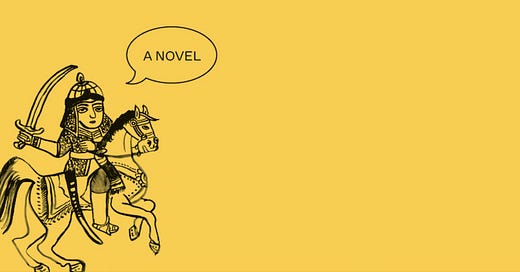The first insect drawn by man was a locust. Art is where what we survive survives. - The Palace
How does one make one’s life meaningful is a question “Martyr!” by Kaveh Akbar attempts to answer. Who’s the exclaimer? That would be Cyrus Shams, a harrowed and humorous Iranian-American poet in his twenties tantalized by death. Newly sober, our main character embarks on a quest to analogize martyrdom, exploring art’s role in it, too.
“Maybe it was that Cyrus had done the wrong drugs in the right order, or the right drugs in the wrong order, but when God finally spoke back to him after twenty-seven years of silence, what Cyrus wanted more than anything else was a do-over. Clarification.”
I shuttered. I was standing before the spot Joan d’Arc was burnt at the stake in 1431. Minutes before, I had taken photos of a purse I liked while the tour guide droned on.
I couldn’t help but immediately think of her after reading this quote. Joan’s posthumous recognition as a martyr and saint mirrors Cyrus’ struggle to find significance in his own suffering and artistic endeavors. The canonical set against the modern mundane.
At an early age, Joan began hearing voices that she attributed to being divine interventions. One told her that Charles of Valois must be named the rightful king of France, which eventually led her to lead an army against the English. Once captured by the enemy, she was put on trial for witchcraft, heresy, and wearing men’s clothing.
Like Joan, Cyrus experiences a divine intervention that serves as a catalyst for his calling, situating him as a could-be martyr. Accumulating a dictionary of martyrs in a Word doc he titles BOOKOFMARTYRS.docx, we read perspectives of his family members and other historical figures, both real and fictional, whom he deems martyrs. Through this process, Cyrus begins to answer his own question, while materializing his pain into his art—words.
“I am setting out to write a book of elegies for people I’ve never met. Yes, there is an unforgivable hubris in my imagining any part of their living, and presuming to write about it. There is also hubris in writing about anything else.”
I like the idea of Cyrus being the scribe of martyrs in an attempt to satisfy his longing for redemption and clarity in a life marred by loss.
To begin his quest, Cyrus serendipitously travels to Brooklyn with his best friend and often lover, Zee. Why? An internationally renowned visual artist who has been diagnosed with terminal breast cancer, Orkideh, decides to turn her final days into an art exhibit called “Death-Speak” at the Brooklyn Museum, one where visitors can speak to her about death.
Cyrus visits the artist over the course of three days, each day providing him with subtly more information than the day before, just as it goes in most quests. The first day, they speak about the idea of earth martyrs, people who give their lives to something larger than themselves. They also speak of his uncle who acted as a living martyr, striding across Iranian battlefields dressed as an angel of death to comfort the dying soldiers. And they speak of the sacrifices she assumed in the name of art. Cyrus desires to understand why she would commit herself to her art rather than her loved ones in her final days, and, in doing so, understand the qualities of a martyr.
“His whole life had been a steady procession of him passionately loving what other people merely liked, and struggling, mostly failing, to translate to anyone else how and why everything mattered so much.”
His visit to the museum provides the clarity he had been missing his entire life, at the expense of Orkideh’s final days. That’s the power of art. Clarity, despite what juxtapositions it may hold. Cyrus, the poet, plays with language so to vocalize his failure to translate the world in such a piercingly perfect sentence capitalizes on the power of his words and the lack of power his words have in attempting to bring both of his parents back to life.
He understood, with a clarity that had until that moment in his life eluded him, that he was not at all made for the world in which he lived, that art and writing had gotten him only trivially closer to compensating for that fundamental defectiveness, the way standing on a roof gets one only trivially closer to grabbing the moon than standing in the dirt.”
My freshman year seminar, ‘Creativity in the Lifespan,’ which made a lasting impact on my life, involved a final project for which we had to trace the life of a creative person, emphasizing their resilience in regard to failures and how they developed their creativity and the turning points of their life regarding creativity, so that we could perhaps internalize and practice their grandeur. Defined by Hunagrian-American psychologist Mihaly Csikszentmihalyi, a leading philosophy in the class was that creativity is the essence of meaning in life. This project feels similar to what Cyrus is doing—making a catalog so that he too can encapsulate the characteristics of a martyr.
It makes sense that Cyrus feels the need to produce a book in order to shepherd meaning to his life and the deaths of his loved ones. And it makes sense that Orkideh felt destined to commit herself to the very act—art—that had sustained her for so many years. For both of them, creation is palliative.
A maestro of painting artful images and conjuring up shattering emotions through collections of words, Kavek Akbar, a poet himself, wrote a book that I desire to read all over again, right away. It’s a poetic exploration of the search for meaning in life and in death, and the power of artistic expression. Now, on to his poems!




